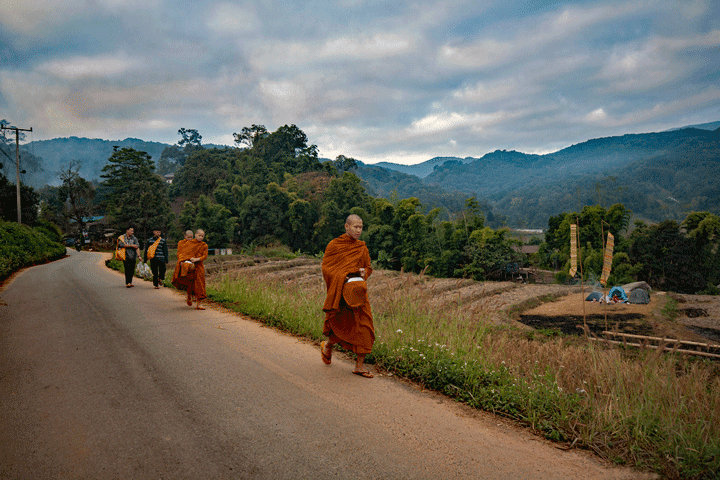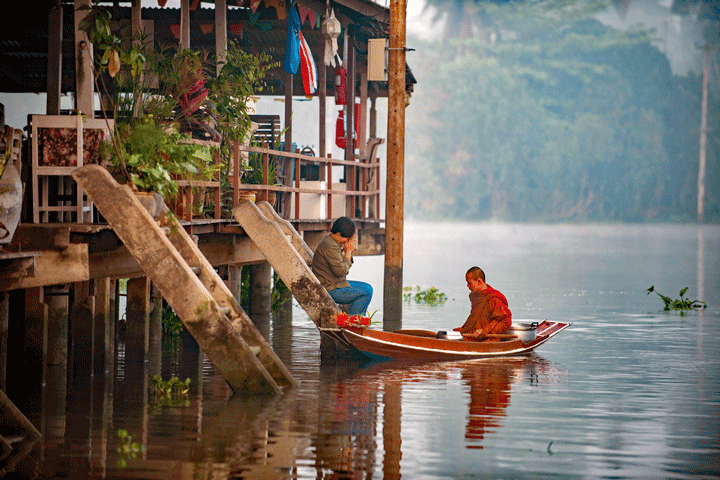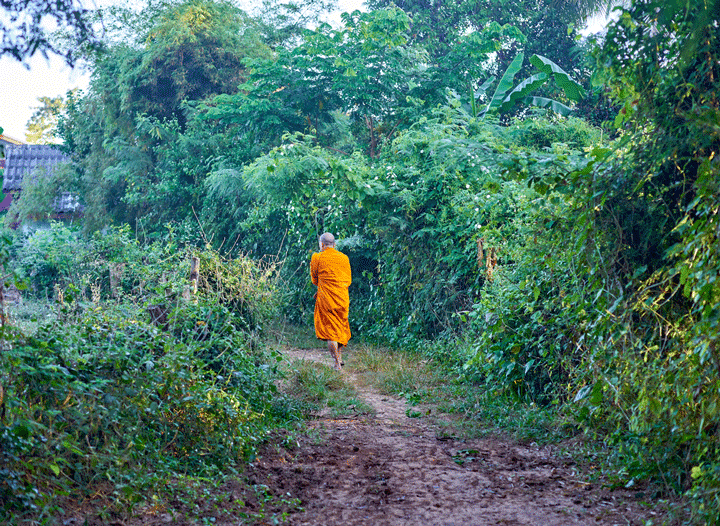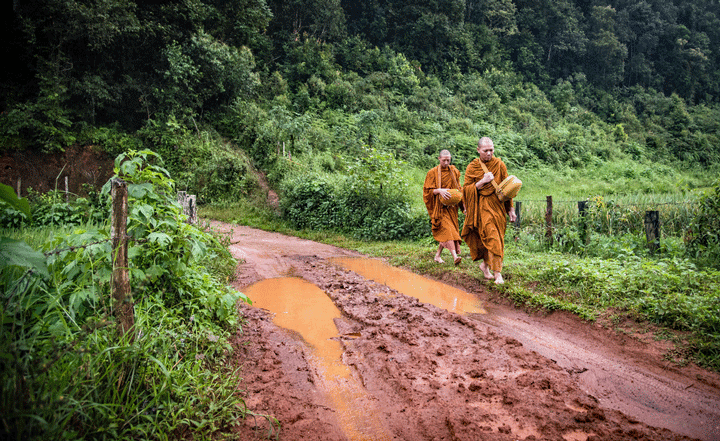The Decline of Village Buddhism
Tino Kuis describes how the practice of Buddhism changed in the first fifty years of the 20th century. These changes coincided with Bangkok's efforts to extend its authority over the whole of Thailand.
A monk reminisces about Songkran in Isan circa 1925:
It did not matter whether the monks or the novices threw water on the women first or whether the women took the initiative. Everything was allowed after the start. The monks' robes and belongings in their kutis were soaking wet. The women ran after the monks when they retreated. Sometimes they only got hold of their robes.
If they seized a monk, he could be tied to a pole of his kuti. During their hunt, the women sometimes lost their clothes. The monks were always the losers in this game or they gave up because the women outnumbered them. The women played the game to win.
When the game was over, someone would take the women with gifts of flowers and incense sticks to ask the monks for forgiveness. It's always been that way.
From the early XNUMXs, Buddhist authorities in Bangkok sent inspectors into the country to assess the practices of monks on the periphery of the developing Thai state. They were baffled by the behavior of monks in the North and Northeast. They saw monks organizing parties, building their own temples, plowing the rice fields, participating in rowing competitions (against women), playing musical instruments and teaching martial arts. In addition, the monks were (herbal) doctors, counselors and teachers.
In the areas and villages where the Thai state had not yet penetrated, this Buddhism had a completely different and completely individual character, different for each area and village. Eventually, village Buddhism was supplanted by the current state system. This happened in the years 1900 to 1960 when the state also imposed its influence over the whole of Thailand. The current practice of Buddhism, and especially that of monasticism, the Sangha, in Thailand is the result of rules imposed from Bangkok on the periphery. That led to the uniform and state-bound Buddhist customs we see today. I call it State Buddhism.

(maodoltee / Shutterstock.com)
Enthusiastic audience
We already read above how monks became involved in Songkran. Another strong example concerns the preaching of the dhamma, the (Buddhist) Teaching. This was usually done by dramatically depicting previous births of the Buddha. The most popular was the penultimate birth of the Buddha, which is supposed to represent generosity.
In Central Thai the Mahachaat (the Great Birth) and in Isan Pha Law mentioned, it is about a prince who gives everything away, a white elephant to another prince, his jewels to a beggar and later even his wife and children. This parable was performed with the monk as actor, accompanied by musical instruments and an enthusiastic, sympathetic audience.
Also female nuns, mae chie called, were an essential part of the Buddhist community. They were often respected as much as their male colleagues.
The inspectors found these practices repulsive, lax and un-Buddhist. But the villagers saw it differently. They were intimately connected with the monks. There was a horizontal relationship, the monk was one with the villagers. The villagers took care of the monks and the monks took care of the villagers. In that situation there was also no question of an authority above the village monk. This form of Buddhism has almost completely disappeared. This popular village Buddhism was replaced by the state Buddhism of Bangkok.
Fear overwhelmed me, sweat broke out on me
Within village Buddhism, the thudong monks played an important role. We could describe Thudong monks as wandering monks. It is derived from the Pali word dhata 'give up, leave' and ang 'state of mind' and they were an integral and important part of village Buddhism.
Outside of the three-month rain retreat, when they taught in temples, they roamed through the then vast forests of northern and northeastern Thailand as far as the Shan states (now Burma) and Laos. The aim was to train their minds and to cleanse their minds through meditation. They believed that then they could face hardships, fears, temptations, and dangers with peace of mind.
A dozen wandering monks left behind writings in which they described their experiences and which also provide more information about village Buddhism. The woods were dangerous places. Wild beasts such as tigers, elephants, leopards, bears and snakes still abounded and the monks often encountered them. This is what the monk Chaup writes about such an encounter (they usually wrote about themselves in the third person, I'll make it first person):
'On the path in front of me stood a tiger the size of an elephant. When I looked back I saw another tiger. They slowly approached me and stopped a few meters from me. Fear overwhelmed me, sweat broke out on me. With difficulty I concentrated my mind. I stood perfectly still and began to meditate. I send metta karona, loving-kindness, out to all the animals in the forest. After perhaps a few hours I awoke to find the tigers gone. [end of box]
Diseases such as 'jungle fever' (probably malaria) and diarrhoea, but also hunger and thirst were common. Inner dangers were sometimes equally threatening. Many were overcome by feelings of loneliness. Some described how they were overcome with sexual lust. The monk Cha writes:
During my alms round, a beautiful woman looked at me and arranged her sarong so that I could see her naked lower body for a moment. During the day and in my dreams I envisioned her sex for days and nights. It took me ten days of intense meditation before I got rid of those images.
Vagrants and lax monks
In the sixties and seventies most of the forests had been cut down, the wandering monks were old to very old and lived permanently in a temple. Having previously been denounced as vagabonds and lax monks, the townsfolk now suddenly discovered these monks as saints. The king visited them in Phrao (Chiang Mai) and in Sakon Nakhorn (Isan). Many writings were dedicated to them, amulets were sold for a lot of money and busloads of believers traveled to the North and Northeast.
An old wandering monk sighed at that time:
'They look at us like a bunch of monkeys. Maybe they'll throw another banana at me when I'm hungry.'
Another commented about these visitors:
'They don't really want to listen to the Dhamma, the Teaching. They want to gain merit but do not want to give up their vices and give nothing for it. They think they can buy merit with money without any effort.'
And Luang Pu Waen in Phrao refused to bless amulets:
“Sacred amulets are worth nothing. Only the Dhamma, the Teaching, is sacred. Practice it, that's enough.'
From village Buddhism to state Buddhism
The Thais are very proud that they have never been colonized. It should be noted that some describe the period after 1850 and after 1950 as semi-colonial when first the British and then the Americans had a very large influence on Thai politics.
But of much greater importance is the observation that large parts of Thailand suffered internal colonization. By that I mean that a small group of most royalist Bangkok administrators imposed their will and their values on the vast periphery of the developing Thai state in a way that went far beyond the colonization of the Western powers.
These colonized areas were in the North and Northeast. Civil servants, and in their wake soldiers, police and teachers, were sent to the periphery in the period 1900 to 1960 and took over administrative tasks from local nobles and rulers. This did not happen entirely without opposition: a number of revolts in both the North and the Northeast at the beginning of the 20th century show this.
The same thing happened with Buddhism. During that period, the village monks were gradually replaced by state monks. Only monks from Bangkok were given the right to initiate other monks. Meditation and the thudong practice was exchanged for study of the Buddhist Pali scriptures and the vinaya, the 227-rule discipline of the monks. The vinaya had to be recited daily in the temple and strictly observed. Perfect execution of rules and rituals was placed above the highest law, the Dhamma, which means compassion and mettaa karuna, loving-kindnes. A few lines from the vinaya:
'teach no more than six consecutive words of the Dhamma to a woman'
'teach a bhikkhuni (full-fledged female monk) not after midnight
'Don't laugh loudly in populated areas'
'Don't talk with your mouth full'
'Don't touch a woman'
'Do not teach the Dhamma to anyone who is standing, sitting or reclining, wearing a turban or in a vehicle (except in case of illness)
Village monks and thudong monks were often unfamiliar with all these rules or did not feel like applying them.
In 1941, the well-known was questioned thudong Monk Man agrees on this in Boromniwat temple in Bangkok:
'I heard that you only follow one rule and not the 227 precepts. Is that true?' asked a monk
"Yes, I follow only one rule and that is common sense," Man replied.
"What about the 227 lines?"
“I guard my mind so that I do not think, speak and act in violation of what the Buddha teaches us. It does not matter whether the discipline consists of 227 rules or more. Mindfulness prevents me from breaking the rules. Everyone is entitled to the opinion that I sin against the 227 precepts.

(lowpower225 / Shutterstock.com)
Another thudong monk, Bua, describes a ceremony:
The thudong monks were clumsy. They held the sacred thread in the wrong hand and the ceremonial fans turned the wrong way to the audience. The public and the other monks were embarrassed, but that did not bother the thudong monks. They remained equanimous.
Here, then, we see the great contract with state Buddhism, which emphasizes above all on perfect observance of the rules alone.
State Buddhism continually affirmed the greater status of monks over laymen. Monks no longer derived that status from the consent of and cooperation with their fellow villagers, but from Pali exams and from titles and honors bestowed by Bangkok. A strict hierarchy was introduced, all authority came from the Sangha Council of Bangkok, a council made up of old to very old men appointed by the state. The state and monasticism became intimately entwined. Monks were put on an untouchable pedestal and detached from the faithful. Form became more important than content.
That is the Buddhist practice we see now, erroneously called traditional Buddhism, and it is in stark contrast to village Buddhism.
Main source: Kamala Tiyavanich, Forest Recollections. Wandering Monks in Twentieth-Century Thailand, Silkworm Books, 1997
– Reposted message –




Thank you Tino for this interesting and fun summary of Buddhism in Thailand. In our European history, too, faith has often been (mis)used by those in power. And the USA, the once 100% secular state of the beginning, can no longer be called that. Exciting business.
This contribution is head and shoulders above the rest! Thought provoking about the role of Buddhism in Thailand. Although Buddhism does not know Rome, Bangkok does play a similar power game. Religion as an instrument to manipulate thought and culture more generally in annexed territories.
The use of religion by those in power has always been a tool in human history to control a population.
This applies not only to occupied or annexed married couples, but certainly also to their own territory.
The annoying thing is that most religions are formed around a pyramid-shaped power structure.
With all its consequences.
More respect for village Buddhism!
Here and there you sometimes come across a monk who adopts an independent attitude.
Who is not much guided by the Sangha.
It strikes me that these monks often have a major influence on how things are done in a temple.
And also often has a group of people around them who are clearly not tried from big city temples.
Refreshing!
They are not "forest monks", but approached understand.
Every now and then you see a monk “walking” in the Isan.
This may also be one of the reasons for the declining interest in Buddhism in Thailand. According to an article in De Telegraaf (not always reliable) people would even start importing monks from Myanmar. Seems like a language problem to me. The former direct and intensive contact with villagers as described above, yes even activity of the monks is no longer. It is curious that the Telegraaf also indicated this as a possible cause. The newspaper: previously monks were active in all kinds of areas.
Education, for example.
Now: a sterile state Buddhism with strict protocols that cannot be deviated from.
The village anarchy has been replaced by a strict hierarchy. The temples here in the Netherlands certainly do not deviate from that.
Long live village anarchy! Get rid of all those rules! Let the monks decide for themselves what to do in the Thai community. Walking around and talking to everyone even to prostitutes like the Buddha did. Otherwise the Sangha, monasticism, and perhaps Buddhism, is doomed.
When the ritual supplants the essence of the teachings, it is little more than magical thinking and acting. Which is more important: right handling of the sacred thread or the Dhamma? I find it very reassuring to read here that the thudong monks also made a mistake with the rituals here and there. I myself often feel very clumsy at these ceremonies. Thanks to this article, I know that that doesn't have to be an obstacle. It is not the hocus pocus that is important, but my attitude and actions must be in accordance with the Dhamma. And that is precisely what all those ceremonial adepts lack. For them: A magical amulet brings material prosperity. A donation to the temple will increase the turnover of the Thai restaurant in the Netherlands (or Bangkok)! Unfortunately, this interpretation of religion is leading in Thai circles, also here in the Netherlands.
Thank you, well worth reading!
Thanks Tino,
I believe that any religion that does not promote the equality of men and women (Ying Yang) is doomed to miss the goal, the incarnation of the Christian consciousness. And read Buddha, Krishna as equivalent.
Wilhelm Reich published a book together with Carl G. Jung, first in the German language, later this book was translated into English. The English title is : 'The Golden Flower'.
Yours faithfully,
Climb.
Leo, absolutely right. The Buddha, somewhat hesitantly and after much urging from his stepmother, also ordained women as full-fledged monks, unique for the time. In India until 1000 AD. there were flourishing women's temples, and still in China and Korea. Unfortunately, that was lost in Thailand.
Ying Yang is a natural thing and a necessity.
Maybe you mean 'The Secret of the Golden Flower'? That is a Chinese work where Carl G. Jung wrote a foreword to the translation.
The village Buddhism with the forest monks was close to the people, part of the local society even if it was not exactly according to the Sangha council's book. As if it matters that people here and there embrace more 'pagan' - so to speak - customs such as animism and brahmanism than what is correct according to those high Sangha monks (which can also be argued as a 'pure Buddhism' is their goal). Give me a forest monk over some lofty chief monk. The book 'Forest Recollections' is really worth reading! Well written and very useful for getting to know society better.